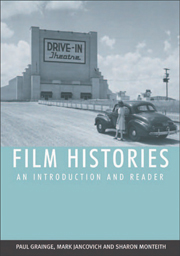Book contents
- Frontmatter
- Contents
- Preface
- Part I Film History from its Origins to 1945
- Part II Film History from 1946 to the Present
- 13 Postwar Challenges: National Regeneration, HUAC Investigations, Divestiture and Declining Audiences
- 14 The Politics of Polarisation: Affluence, Anxiety and the Cold War
- 15 Cinematic Spectacles and the Rise of the Independents
- 16 New Waves, Specialist Audiences and Adult Films
- 17 Radicalism, Revolution and Counter-Cinema
- 18 Modernism, Nostalgia and the Hollywood Renaissance
- 19 From Movie Brats to Movie Blockbusters
- 20 The Exhibitors Strike Back: Multiplexes, Video and the Rise of Home Cinema
- 21 Postmodernism, High Concept and Eighties Excess
- 22 Cults, Independents and ‘Guerrilla’ Filmmaking
- 23 From Cinemas to Theme Parks: Conglomeration, Synergy and Multimedia
- 24 Globalisation and the New Millennium
- Bibliography
- Copyright Acknowledgements
- Index
21 - Postmodernism, High Concept and Eighties Excess
from Part II - Film History from 1946 to the Present
Published online by Cambridge University Press: 05 August 2013
- Frontmatter
- Contents
- Preface
- Part I Film History from its Origins to 1945
- Part II Film History from 1946 to the Present
- 13 Postwar Challenges: National Regeneration, HUAC Investigations, Divestiture and Declining Audiences
- 14 The Politics of Polarisation: Affluence, Anxiety and the Cold War
- 15 Cinematic Spectacles and the Rise of the Independents
- 16 New Waves, Specialist Audiences and Adult Films
- 17 Radicalism, Revolution and Counter-Cinema
- 18 Modernism, Nostalgia and the Hollywood Renaissance
- 19 From Movie Brats to Movie Blockbusters
- 20 The Exhibitors Strike Back: Multiplexes, Video and the Rise of Home Cinema
- 21 Postmodernism, High Concept and Eighties Excess
- 22 Cults, Independents and ‘Guerrilla’ Filmmaking
- 23 From Cinemas to Theme Parks: Conglomeration, Synergy and Multimedia
- 24 Globalisation and the New Millennium
- Bibliography
- Copyright Acknowledgements
- Index
Summary
The 1980s are often thought of as a period defined by excesses of style and consumption, a ‘postmodern’ moment where the aesthetics of consumer culture – typified by the promotional flow of music video on television channels such as MTV – came to the fore. It is in this period that Hollywood film assumed a particular style that movie executives would label ‘high concept’. Responding to key industrial developments in the 1980s, such as the widespread adoption of marketing research and the growth of ancillary markets (such as music soundtracks), high concept movies were often based on pre-sold elements such as a best-selling book or a comic strip, and emphasised a distinctive style, conveyed in sleek images and music, which were integrated with their marketing. According to Justin Wyatt, the marketing ‘hook’ functioned alongside the stylistic ‘look’ within the spectrum of high concept. Whether soundtrack-driven movies such as Flashdance (1983), Top Gun (1986) or Dirty Dancing (1987), teen genre films such as The Lost Boys (1987) or Young Guns (1988), or high-budget blockbusters like Dick Tracy (1990), high concept films mobilised bold images and music, and the marketability of particular stars, to maximise their presence and appeal.
The most significant figures to popularise high concept filmmaking in the 1980s were the producers Don Simpson and Jerry Bruckheimer. Making a stream of hits for Paramount, their films were defined by a powerful blend of visual imagery and popular music, a rock video style of filmmaking that often relied on extended montage sequences cut to music.
- Type
- Chapter
- Information
- Film HistoriesAn Introduction and Reader, pp. 483 - 503Publisher: Edinburgh University PressPrint publication year: 2007



